Ad
Programming in scala - 1
- 1. Programming in Scala By: http://changingtechblog.blogspot.in/
- 2. Why Scala ● Java did wonderful things with its motto of "write once and run everywhere" but thats half the story ● Abundance of boilerplate in java ● Java provided lower level of abstraction but its very difficult to write multithreaded applications in java which runs as expected ● Multi core processors has opened an entire new dimension in programming world ● Thread safety, Visibility of data(Concurrency) ● Java as a language hasn't evolved much since its inception but JVM has evolved up to the extent that its performance has surpassed with native written code
- 3. What is Scala ● Scala is port of many years of academic research on JVM ● SCAlable LAnguage ● Statically typed ○ A variable is bound to a particular type for its lifetime its type can't be changed and it can only reference type-compatible instances ○ In dynamic typing the type is bound to a value not the variable so a variable might refer to a value of type A then be reassigned to a value of unrelated type X ○ Ruby, Python, Groovy, Javascript and Smalltalk are dynamically typed
- 4. What is Scala ● ● ● ● ● ● Scripting language Functional language Object Oriented language Concise and flexible syntax Sophisticated type system Scalable (performance)
- 5. JVM Languages Scala Other JVM Languages JAVA iconst_1 istore_1 iconst_1 istore_2 iload_1 iload_2 iadd int2byte istore_3 iload_3 ireturn JVM Clojure, Groovy, JRuby, Jython, Rhino, Fantom, Kotlin ... see also
- 6. Installation ● Unix ○ Command line Download, Extract jar file and add its "bin" directory in classpath ○ Scala IDE Download ● Windows ○ Command line Download, Extract jar file and add its "bin" directory in path variable ○ Scala IDE Download ● Other methods ○ Download STS or Eclipse and add scala ide as a plugin ○ Download Intellij-Idea community version and install scala as a plugin
- 7. A taste of Scala ● ● ● ● ● ● ● ● REPL (Read eval print loop) $ scala scala> scala> :help scala> :imports scala> println("Hello World") scala> printf("%d", 1) scala> 1 + 2 res0: Int = 3 ● scala> 1 + "to string will be called" res1: String = 1to string will be called ● Scala worksheet in eclipse
- 8. A taste of Scala Continued ... class Upper { def upper(strings : String*) : Seq[String] = { strings.map((s : String) => s.toUpperCase()) } } val up = new Upper println(up.upper("I", "am", "using", "Scala", "as", "scripting", "language")) run as - scala upper-script.scala object Upper { def main(args : Array[String]) = { args.map((s : String) => s.toUpperCase()).foreach(printf("%s ", _)) println("") } } run as - scalac upper.scala scala -cp . Upper I am using scala from compiled file
- 9. Type less do more ● No Semicolons ○ Fewer characters to clutter your code ○ Increases code readability by breaking statements in separate line ● Curly braces are not mandatory in all cases ○ class A ○ def add(a : Int, b : Int) = a + b ● 'return' keyword is optional ● Method without parentheses and dots ○ ○ ○ ○ "hello".length() vs "hello".length vs "hello" length 1. +(2) vs 1 + 2 def isEven(n : Int) = n % 2 == 0 List(1,2,3,4) filter isEven foreach println ● if statements are expressions in scala so there is no special ternary conditional expression
- 10. Variable declaration ● val ○ immutable (read only) ○ scala> val array : Array[String] = new Array(5) scala> array(0) = "Hello" scala> array ○ scala> val list : List[Int] = List(1,2,3) scala> 23 :: list scala> list ● var ○ mutable ○ can assign a new value as often as you want ● Both val and var must be initialized when declared ● except in abstract types and constructor arguments Scala encourages you to use immutable variables whenever possible
- 11. Literals ● Integer literals ○ Byte, Char, Short, Int, Long ○ 'l' or 'L' is required for Long ● Floating-Point literals ○ Float, Double ○ 'f' or 'F' is required for Float ○ 'd' or 'D' is optional for Double ● Boolean (true, false) ● Character literals ○ Printable unicode character or an escape sequence written between single quotes. Try 'u0041' ● String literals ○ Sequence of characters enclosed in double quotes or triples of double quotes. Try "Tabtis escaped", """Tabtis not escaped in triples of double quotes"""
- 12. Literals Continued ... ● Symbol literals ○ symbols are single quote followed by a letter followed by zero or more digits or letters ○ these are interned strings meaning two symbols with same name will actually refer to same objects. ○ Try 'id, '1 ○ Not used much in scala but popular in other languages like Ruby, Smalltalk and Lisp ● Tuples ○ To return multiple values in java either pass it in method parameters or return a object or a class which contains these values ○ scala has built in support for tuples of members from 1 to 22
- 13. Literals Continued ... ● Function literals ○ Function literal is an alternate syntax to define a function ○ val add = (a : Int, b : Int) => a + b ○ val test = () => System.getProperty("user.dir") ○ Useful for passing as argument in higher order functions ● Other literals ○ List ■ val v1 = Nil ■ val fruit = List("orange", "mango") ○ Map ■ val stateCapital = Map("UP" -> "Lucknow", "Bihar" -> "Patna") ■ val districtCount = Map(("UP", 84), ("Bihar", 40))
- 14. Identifirs ● Scala allows all printable ASCII characters except parenthetical characters ( ) [ ] { } and delimeter characters ` ' " . , ; ● It also allows operator characters such as + - % / < > etc ● Reserved words can't be used ● Underscore is important it tells the compiler to treat all characters up to next whitespace as part of identifier ● After underscore you can have either letters and digits or a sequence of operator characters but you can't mix them with letters and digits ● An identifier can also be arbitrary string between two back quote characters
- 15. Classes class Person(firstName : String, lastName : String, age : Int) {} ● Primary Constructor - defined with class declaration ● Auxiliary Constructor - defined as a method this(.....) ● Constructor arguments can have access modifier such as ● ● private, protected etc. Arguments in primary constructor becomes instance variables with setters and getters automatically generated depending upon variable scope, like val, var private, protected. Methods, instance variables can be overridden in subclass using override keyword Example: 'override def toString = "" '
- 16. Classes continued ... Subclass must extend one of the constructor of superclass class Person(name : String, val age : Int) { def this() = this("No name", 25) def incrementAge(value : Int) = age += value } // Extending primary constructor class SmartPerson(name : String, override val age : Int) extends Person(name, age) *** override keyword is must with vals // Extending Auxiliary constructor class UnknownPerson extends Person { override def incrementAge(value : Int) = { if(value > 0) super.incrementAge(value) else throw new Error("Value can't be < 0)
- 17. Method declaration ● Starts with a def keyword followed by optional argument list, a colon character and the return type of the method, an equal sign and finally the method body ● Method arguments can have default value ● Method parameter order can be changed by caller ● Method definition can also be nested
- 18. Abstract Class ● Starts with abstract keyword, It can have both primary and auxiliary constructors ● If a method doesn't have a body then it automatically becomes abstract same for instance variables ● Abstract method must only be declared in abstract class or traits but not in concrete class ● Abstract class may not contain any abstract method or field but its subclass must override all abstract members except if it another abstract class or trait abstract class Vehicle(val model : String) { val engineNumber : String var fuel : Double def addFuel(amount : Double) } class Car(override val model : String) extends Vehicle(model) { val engineNumber = "dfdf" var fuel = 0 def addFuel(amount : Double) ... }
- 19. equals and hashcode ● java 'equals' equivalent in scala is 'eq' ● See Scala Source Code ● Scala provides 3 methods for checking equality of objects/references ● eq -> final method in AnyRef, checks equal reference ● equals -> calls eq in AnyRef, must override it if you want to check object equality instead of reference equality, structure def equals(that : Any) "that must be Any" ● == -> final method which calls equals with null checked ● ne -> anti of eq ● must override hashcode whenever overriding equals ● Example in Person class
- 20. Companion Object ● A way to create singleton object, and separate class level stuffs with object level stuff ● starts with 'object' keyword in place of 'class' in class declaration except that it has only default constructor ● It must be defined in same file with same name as actual class for which it is a companion object ● apply, unapply methods class Rational(x: Int, y: Int) { ... } object Rational { def apply(x : Int, y : Int) = new Rational(x, y) def unapply(rational : Rational) = if(rational == null) None else Some(rational.numer, rational.denom) ● Now we can define val rational = Rational(23, 45) val Rational(x : Int, y : Int) = Rational(4, 5)
- 21. Use of None instead of null ● Scala discourages the use of null to avoid NullPointerException or unnecessary null check ● It provides two implementations of Option[+A] sealed abstract class ● None -> container has no value ● Some -> container has some value ● If a method can return null then it must be returned as Option [A] ● Always try to use getORElse rather than get Example: scala> var x : Option[String] = None scala> x.get scala> x.getOrElse("No Value") scala> x = Some("has some value") scala> x.getOrElse("No Value") scala> x = Option(null) scala> x = Option("Something")
- 22. Discussions ● ● ● ● List, Vector, Stream Last session exercises Package objects File IO
- 23. Traits ● Same as java interfaces with ability to have implementation of methods and variable declaration ● It solves boilerplate code generated with using java interface ● It also gives ability to compose behaviour on demand trait Culture trait SouthIndianCulture extends Culture trait BihariCulture extends Culture trait ModernCulture extends Culture class Person extends Culture val mukesh = new Person with BihariCulture with ModernCulture val modernPerson = new Person with ModernCulture val idiot = new Person
- 24. Traits Contd ... ● Traits can't have primary or auxiliary constructors ● A class can mixin multiple traits using "with" keyword except first trait starts with "extends" ● It has a well defined algorithm for the order in which it is called when a class is mixed in with multiple traits ● It provides late binding "super call from a trait depends upon the order in which it is mixing in" trait A trait B extends A trait C extends B class D extends A with B with C *Start with Class and then from right to left write its name expand if needed D - The class DCBA - Expande C D C B A B A - Expand B D C B A B A A - Expand A Now starting from right keep first one and remove any other repetition of that type D C B A ScalaObject AnyRef Any - This will be final call order
- 25. Traits Contd ... ● Traits can extend a class, abstract class which has no parameter primary or auxiliary constructor ● self type - mechanism to refer to "this" trait T1 trait T2 { self => } trait T3 { self : T1 => } // fine class C extends T2 // Compilation error, it must extend T1 because it was force in // definition of T3 class C1 extends T3
- 26. Types ● Type is a set of information the compiler knows which is used to infer whether a statement will succeed or fail ● In Scala A type can be one of object, class, trait or defined with type keyword ● class and trait types are accessible directly but object types are accessed with objectname.type ● Structural type defines what method/variable signature you might expect on a particular type. It should be avoided as it uses reflection Example object O type abstractType type concreteType = String type concreteType = C with T type objectType = O.type
- 27. Structural Types // A type closeable must have close method type Closeable = {def close : Unit} // Define a method with parameter closeable def testClose(closeable : Closeable) = closeable.close // We can call this method on any class or trait which has // close method in its scope, above method is applicable for all three class C { def close = println("closing in C") } trait T { def close = println("closing in T") } class C1 extends T







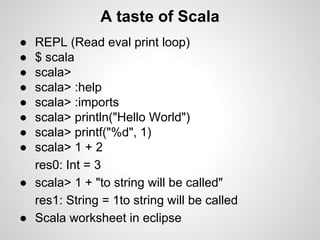
![A taste of Scala Continued ...
class Upper {
def upper(strings : String*) : Seq[String] = {
strings.map((s : String) => s.toUpperCase())
}
}
val up = new Upper
println(up.upper("I", "am", "using", "Scala", "as", "scripting", "language"))
run as - scala upper-script.scala
object Upper {
def main(args : Array[String]) = {
args.map((s : String) => s.toUpperCase()).foreach(printf("%s ", _))
println("")
}
}
run as - scalac upper.scala
scala -cp . Upper I am using scala from compiled file](https://image.slidesharecdn.com/programminginscala-140214054718-phpapp02/85/Programming-in-scala-1-8-320.jpg)

![Variable declaration
● val
○ immutable (read only)
○ scala> val array : Array[String] = new Array(5)
scala> array(0) = "Hello"
scala> array
○ scala> val list : List[Int] = List(1,2,3)
scala> 23 :: list
scala> list
● var
○ mutable
○ can assign a new value as often as you want
● Both val and var must be initialized when declared
●
except in abstract types and constructor arguments
Scala encourages you to use immutable variables
whenever possible](https://image.slidesharecdn.com/programminginscala-140214054718-phpapp02/85/Programming-in-scala-1-10-320.jpg)

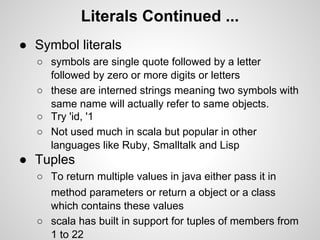

![Identifirs
● Scala allows all printable ASCII characters
except parenthetical characters ( ) [ ] { } and
delimeter characters ` ' " . , ;
● It also allows operator characters such as + - %
/ < > etc
● Reserved words can't be used
● Underscore is important it tells the compiler to
treat all characters up to next whitespace as
part of identifier
● After underscore you can have either letters and
digits or a sequence of operator characters but
you can't mix them with letters and digits
● An identifier can also be arbitrary string
between two back quote characters](https://image.slidesharecdn.com/programminginscala-140214054718-phpapp02/85/Programming-in-scala-1-14-320.jpg)






![Use of None instead of null
● Scala discourages the use of null to avoid
NullPointerException or unnecessary null check
● It provides two implementations of Option[+A] sealed
abstract class
● None -> container has no value
● Some -> container has some value
● If a method can return null then it must be returned as Option
[A]
● Always try to use getORElse rather than get
Example:
scala> var x : Option[String] = None
scala> x.get
scala> x.getOrElse("No Value")
scala> x = Some("has some value")
scala> x.getOrElse("No Value")
scala> x = Option(null)
scala> x = Option("Something")](https://image.slidesharecdn.com/programminginscala-140214054718-phpapp02/85/Programming-in-scala-1-21-320.jpg)
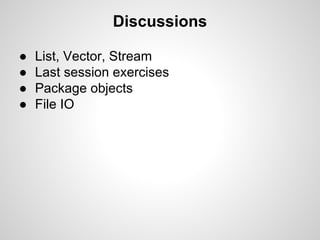

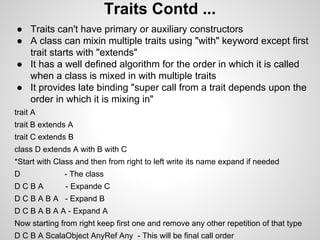
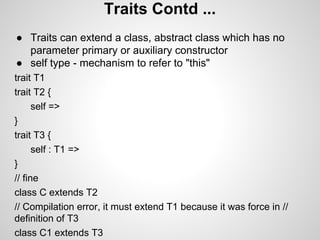
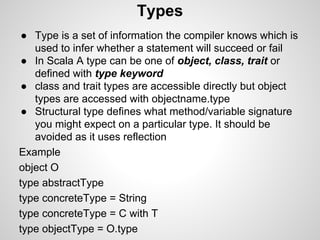

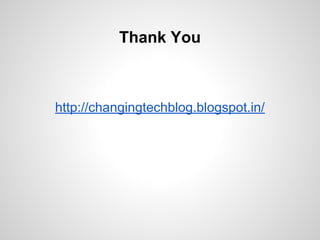














































![[Expert Fridays] Java MeetUp - Борис Ташкулов (Teamlead Enterprise): "Почему ...](https://cdn.slidesharecdn.com/ss_thumbnails/scala-161010110350-thumbnail.jpg?width=560&fit=bounds)








































